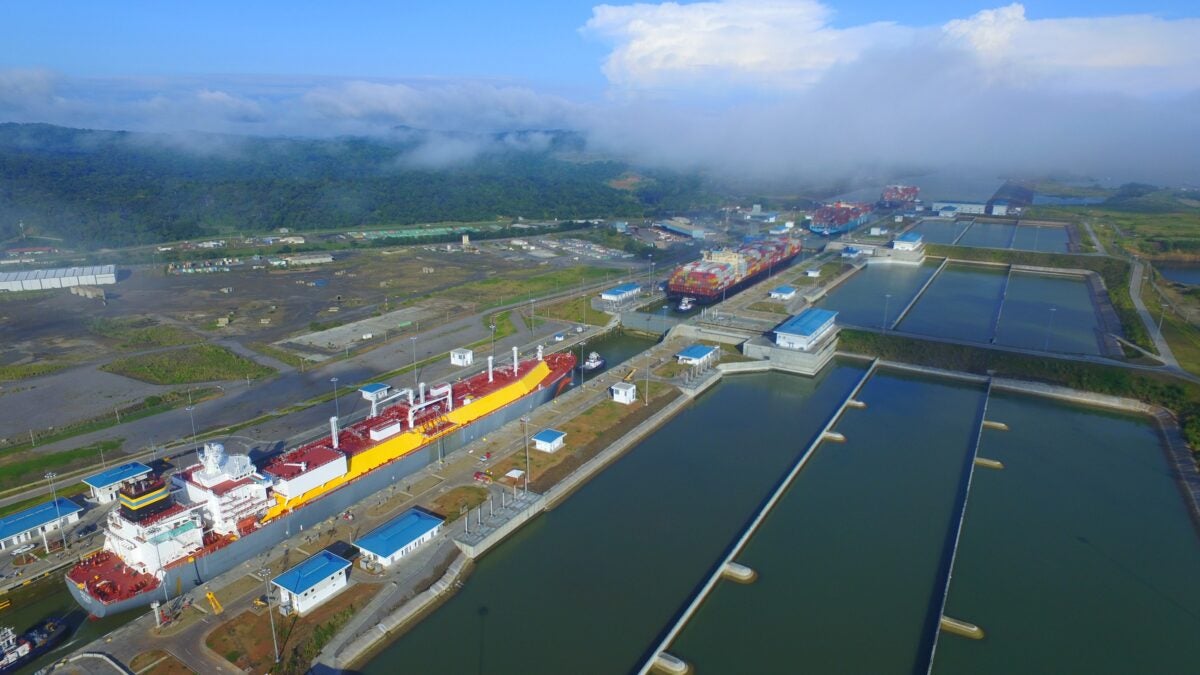Freight News:
Top ocean shipping stories of 2023: War, drought and detours
Ocean shipping routes are always in flux, but 2023 took it to a whole new level.
Trade routes were blocked or impeded by geopolitics, labor and weather: sanctions on Russia, U.S.-China tensions, dockworker union unrest, drought-driven cuts at the Panama Canal, and attacks on ships in the Red Sea.
Ocean trade detoured around each obstacle. When vessels divert in large numbers, it makes headlines, but that flexibility is one of ocean shipping’s greatest strengths. Ship diversions, as the software saying goes, are a feature, not a bug.
Here’s a look back how FreightWaves covered of a year when ships kept on changing course:
Russia-Ukraine war reroutes tanker and bulker flows
The EU shift away from Russia began in December 2022, with the EU ban on Russian crude, and accelerated in February 2023, with a ban on Russian diesel and other refined products.
The shuffle of global trade flows went into full swing. Russian crude went to China and India instead of the EU. Russian diesel went to Africa and South America. The EU replaced its Russian crude and diesel with volumes from the U.S. and Middle East (story here) — and none of these changes caused fuel prices to spike.
Not only did the destinations change for Russian exports, the fleet of tankers carrying those cargoes changed.

In response to sanctions, Russian cargoes were initially carried by the so-called “shadow fleet,” tankers outside Western financial and insurance circles (story here). Then, courtesy of the price-cap “loophole,” they switched to European tankers (story here). And then, when the price cap was breached, they switched back to shadow tankers (story here).
Trade routes for liquified natural gas (LNG) shipping also saw a huge shift due to the war. Previously, two-thirds of U.S. LNG went to Asia, one-third to Europe. This year, two-thirds went to Europe, one-third to Europe (story here).
The Russia-Ukraine war likewise reshuffled dry bulk routes.
Russian coal that previously went to the EU went to India and China instead. The EU replaced Russian supply with coal from Colombia, South Africa, the U.S. and Australia (story here). Ukrainian wheat impeded from leaving via the Black Sea due to the war was replaced by Russian wheat (story here). Global trade reflowed to keep markets supplied.
Trouble ahead: Tensions with China mount
The separation of Russian and Western supply chains was only part of a broader trend that involved China, as well. More Chinese military exercises off Taiwan this year heightened tensions with the U.S.
In general, shipping fleets and cargo flows grew increasingly bifurcated, with the U.S. and EU on one side, and Russia and China on the other (story here).
Geopolitical tensions coincided with a much-weaker post-COVID economic recovery in China than expected, a negative for shipping demand (story here).
More Chinese containerized exports went to Asian countries in 2023, and less to the U.S., with the U.S. sourcing more containerized imports from Southeast Asia and India. But this trade reshuffle has a long way to go.
The U.S. remains extremely reliant on Chinese cargo, which still represented 37% of total containerized imports in November (story here). Thus, the stage is set for a massive supply chain shock in the years ahead if China invades Taiwan.
Leland Miller, CEO and founder of China Beige Book, warned FreightWaves in November: “The odds of something happening before the end of the decade are much, much higher than the markets are giving credit for. The market understanding of this — that it’s way too damaging so it’s not going to happen — is just wrong (story here).”
Labor unrest and the coastal shuffle
Meanwhile, on the domestic front, the first half of this year was dominated by fears of dockworker labor unrest at West Coast ports as the International Longshore and Warehouse Union (ILWU) engaged in contentious negotiations over pay and COVID bonuses (story here).
Importers reacted by rerouting some of their supply chains to the East Coast and Gulf Coast ports, causing volumes in Los Angeles and Long Beach to plummet (story here).
In the second half of the year, trade flows began to shift in the opposite direction. The ILWU reached a contract agreement in June, removing concerns about West Coast ports, and water-level restrictions at the Panama Canal increased, raising importer concerns about East and Gulf Coast ports. West Coast volumes bounced back (story here).
Then the labor threat switched coasts. In November, the International Longshoremen’s Association (ILA), representing East and Gulf Coast dockworkers, warned members to prepare for a strike in October 2024, when the current contract expires (story here).
That deadline may be 10 months away, but importers are already planning which coast to send their cargo to next year.
Importers are “very aware” of the risk, Flexport’s global head of ocean procurement, Nerijus Poskus, told FreightWaves. “Next year, it’s inevitable that some share will temporarily shift back to the West Coast (story here).”
Panama Canal slashes transit capacity
The Panama Canal began warning about a historic drought and the potential effect on transits in August. At that point, delays for some vessel types were not as extreme as they had been in past droughts, and the seriousness of the situation was still unclear (story here).
In the coming months, however, it became obvious that this time was different. The canal had its driest October on record. In November, the canal announced extreme measures to slash transits and preserve water (story here).
Prior to November, one of the major impacts of canal restrictions involved larger tankers designed to carry liquefied petroleum gas (LPG) — propane and butane. Uncertainty over delays caused larger LPG carriers to avert the Panama Canal and reroute to the Suez Canal or Cape of Good Hope, increasing average voyage distance and pushing up spot rates (story here).

In November, waiting times for ships without reservations at the Panama Canal surged (story here).
Canal restrictions began hitting Asia-U.S. container shipping flows for the first time (story here).
Two of the three global container shipping alliances — Ocean Alliance and THE Alliance — rerouted their Asia-East Coast services from the Panama Canal to the Suez Canal. And that ultimately led to even more diversions..
Israel-Hamas war and Red Sea attacks
The onset of the Israel-Hamas war in October spurred concerns over two key shipping chokepoints: the Strait of Hormuz off Iran and the Suez Canal (stories here and here).
As it turned out, the risk was at the Suez — not because of issues related to the canal, but because any ships transiting the waterway had to pass through the Bab-el-Mandeb Strait off Yemen.

Yemen’s Houthi rebels began attacking ships in the strait in retaliation for Israel’s treatment of Palestinians, initially attacking Israeli-linked ships (story here).
Israeli carrier Zim (NYSE: ZIM) was one of the first companies to divert from the Suez/Red Sea route (story here).
Then the Houthi attacks became more indiscriminate (story here). All of the container shipping lines, as well as numerous operators of bulk commodity vessels, opted to switch to the much-longer Cape of Good Hope route and avoid the Suez and the Bab-el-Mandeb Strait (stories here and here).
It was yet another case of a “double switch” in 2023 routing. Just as some U.S. importers opted to leave the West Coast earlier in 2023 and switch back to that coast later this year, some ocean carriers that switched from the Panama Canal to the Suez Canal had to change course yet again, and divert to the Cape of Good Hope.
The saving grace for supply chains is that there’s plenty of excess capacity in container shipping, due to a historic tidal wave of newbuilding deliveries hitting the water just as the dual canal issues emerged (story here). There is enough capacity to handle the diversions.
For all of the ship detours due to war, labor and weather, there was no supply chain crisis in 2023. The inherently flexible networks of ocean shipping worked as designed.
Click for more articles by Greg Miller
Related articles:
- 2022’s top shipping stories: Container boom ends, war fuels tankers
- 2021’s top shipping stories: From Ever Given to epic California port pileup
- Container shipping’s stranger-than-fiction first half of 2021
- Top stories of 2020: Inside ocean shipping’s wild ride
- 2019 Recap: Top ocean shipping interviews of the year
The post Top ocean shipping stories of 2023: War, drought and detours appeared first on FreightWaves.
Source: freightwaves - Top ocean shipping stories of 2023: War, drought and detours
Editor: Greg Miller